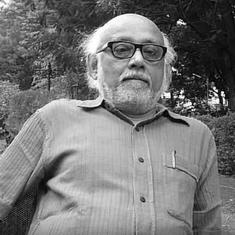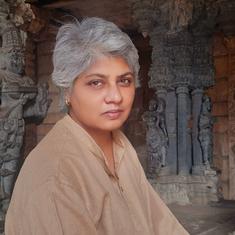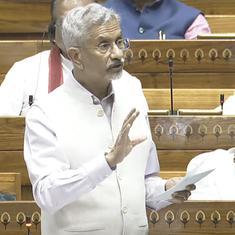Seemantini Updesh (A Tract for A Married Woman), is a rare 19th-century Hindi work rooted in what we now recognise as feminist epistemology. The author is an anonymous Hindu woman (ek agyat hindu aurat, the book says), who perhaps lacked the facility to write Hindi in the Devanagari script. So, she dictated the text to one Pandit Rishi Ram Gaur of Ludhiana, a man who understandably had a better grasp of the newly standardised Hindi as well as the script .
In 1882, when the tract was first published, attitudes towards Hindi as well as female literacy and education were undergoing dramatic changes. The British government, to bridge the communication gap between its officials and Indians, sought to develop standardised scripts, grammar and punctuation marks for Urdu and Hindi since common folk had no access to Persian or English.
Given that and the abysmally low number of literate women at the time, the text’s first print run of 300 copies is substantial. Seemantini Updesh was first published from Lahore, then the print capital for Indian vernaculars. In September 1988, it was reprinted (published by Shesh Sahitya Prakashan, NOIDA, Uttar Pradesh) by the noted Dalit thinker and activist the late Dr Dharmvir.
The immediate reason for its revival, he said in the preface to the reprinted version, was the Roop Kanwar Sati case – when an 18-year-old who had killed herself in her husband’s funeral pyre in Rajasthan in 1987 – that had shaken the nation’s conscience. While zealots, in the name of community sentiments, demanded that there must be no probe into what was obviously an illegal death, Dr Dharmvir decided it was time for Indians to re-read Seemantini Updesh, a voice of sanity from our collective past.
The voice of the unknown author who exposes and castigates the hypocrisy and double standards of Hindus is that of a mature woman. It is at once learned and street smart, sassy and philosophical. She bluntly denounces the patriarchal Hindu tradition of the northern plains, which allowed men to treat women as dispensable shoes (“pair ki jooti”) in the name of culture and tradition. It is equally sharp on women who accept their place within the family quietly, without a whimper of protest, as their duty and their Karma.
The author appears be a well-travelled and childless dowager from a prosperous Hindu family in Punjab, influenced by teachings of the reformer Swami Dayanand Saraswati. She had obviously received enough education to be able to quote the saint poet Tulsidas, the Smritis and the Dharmshastras. It is hard to tell if the author was a native Punjabi , but she seems to know lives of women of Punjab and the western Uttar Pradesh, especially the Agra region, well.
She obviously came across English women regularly and admires them frankly for their liberal attitudes towards clothes, education and the relative ease with which they talk to men. She, however, does not urge Hindu women to convert but to adopt their best practices, such as discarding heavy jewellery used by families to buy their loyalty and silence . She also asks Hindu women to rethink their ornate but uncomfortable clothes that only help impede mobility and make them unnecessarily self conscious.
The publisher of this remarkable tract was one Munshi Kanhaiya Lal Alakhdhari of Lahore, who is thanked liberally in the preface as a man who supported the cause of justice. Little else is known about the publisher or even the nature of the interaciton or contract between author and publisher.
There are a few other good men mentioned in the preface, described as rare gems who must be thanked by all Hindu women in need of emancipation: Shiv Narayan Agnihotri editor of Biradar e hind, Rai Novin Chand ji, who authored several books for women and Swami Dayanand Saraswati, the founder of Arya Samaj and its many educational institutions.
Some translated excerpts from the tract:
On jewellery
“What a woman loves most of all in the world, is not her son, husband, father or brother, but her jewellery. They receive neither education nor the training for any type of remunerative work. They just dream on of a day when they will be married and get to adorn themselves with loads of jewellery. …whatever they get is never sufficient..those that have no jewellery avoid being seen in public and those that have strut about in all social gatherings and take care to be see and admired…
“Oh you wearers of nose rings, who will bore holes in your own bodies to hang gold from, aren’t you ashamed of yourselves in the mirror? If you say the nose ring is a sign of your being married, ask yourselves what sign of matrimony do the husbands display? If you say our ancestors willed this, I ask you which Dharmshastra , which chapter in Manu’s Smriti, ordains that women tear holes in their noses to wear a nose ring?
“...I also ask you what use are glass bangles that often cause would when they break?...when a husband dies the widow must have her glass bangles removed. Does marriage lie in glass bangles then?...Married women in Punjab or in England never wear glass bangles, does that kill their husbands?...I am told this is a tradition created by our family elders. Ask yourselves, were they not ordinary mortals too? Were they born through some other means and not through the usual channels?
“In Mahabharata and the Puranas they frequently break tradition to make their lives easier. Why not accept that tradition from our past?...Remember these are shackles. And until you remove them yourself, you will not be able to liberate yourselves. The western women who wear no bangles or toe rings as mark of being married, also have loving husbands who wait on them. And once he dies, they are free to remarry. You, who have marked your arms and legs with gashes and wounds with your so called Suhag jewellery, are destined to remain a tearful widow forever once you lose your husband.
“Try, to substitute your husband for these trinkets you hug close to your heart so he shall not go astray…Even a labourer after his day’s work is over, goes to bed in easy to wear clothes whereas you, my rich sisters, carry your gold chains and baubles on your back like a slave. Think about it!”
On traditional clothes
“A long skirt, a short top and a scarf, this is what all women from ‘good families’ are permitted to wear...If someone were to say the flyaway skirt exposes more than it covers when there is a breeze or when we climb up stairs, they are told Pyjamas are only worn by Tawaifs, not housewives. That means those who are shy must dress shamelessly and those who wish to display their bodies must look coy? What is this? If you say these skimpy tops do not cover us well, why cant we wear Kurta or Kurtis? We are told Kurtas are worn by the traders and if you wish for the Kurtis that Christian Mems wear, you must become a Christian.
“So what is Hinduness? If covering your bodies better is Christian, is being a Hindu opting for nakedness?...If our men have opted for suits and boots like the Christian men, why must we be denied western clothes?
“Most women wear what they are given to wear. Their approval is neither sought nor asked for. Men buy what they wish for their wives, usually cheap stuff. They change their clothes three times a day but expect wives to change may be 12 times a year…
“Oh you men, who first ensure that your wives stay filthy and smelly and then using that as an excuse to look around for young girls or boys to satisfy yourselves, the stench from your wives clothes has polluted your minds and souls as well. And you are also solely responsible for the various reproductive illnesses such perennial lack of hygiene causes among your women…think what face will you show The One Above, when he questions you on such injustices?”
On why women go astray
“It starts with bad thoughts arising in one’s heart. There are various reasons for this. The first, not getting married. Second, becoming a widow at a young age. Third, being married to an old man. Fourth, being married to a boy much younger than oneself. Fifth, constant friction with the mother-in-law and sisters in law. Six, the husband’s promiscuous ways. Seventh, unsatisfied basic needs for food and clothes. Seven, utter degrading poverty and nine, having a lot of money and assets and a total control over every thing owned.”
On widow remarriage
“When God made woman, He gave her all the senses that He had given a man. So if the man dies, there is no logical reason why his wife who is alive, should lose her sensuality as well. So long as one is alive, the senses will demand they be satisfied. No one can stop this. Not even major saints and Mahatmas...earlier when her husband died, Indians would cremate the widow with his body to foreclose this. No longer. I pity the Indians who will not allow a widow to remarry and force her to stay at home, and expect her to remain a total celibate...You can lock up the body but what of the mind?
“There is no harm in a widow marrying again. God will not take exception to this either. He not only forgave the great saints like Yagyavalkya, Kashyap and Manu for remarriage but also guaranteed them a place in heaven and a perpetuation of worldly fame. The Hindu and Muslim men who marry 10 times while their first wife is still alive, share no blemish do they? Why then should a widow alone be made to consider remarriage sinful?
“Yagyvalkya says, if the husband goes to another land for more than eight years, a Brahmin woman can remarry, and if she is childless, she may wait for four years before seeking another husband. A Kshatriya woman should wait for six years and if childless, she can remarry after three years. A Vaishya woman should wait for four years and if she has no son, she can marry after two years. For an outcaste woman, there is no waiting period, she can remarry whenever she wants.
“This law wrongly discriminates between castes. The Dharmashastras (forbidding widow remarriage etc) were probably created after the Puranas...see Mahabharata, if a woman is not supposed to sleep with another man how was the king Pandu born? How were Arjuna, Yuddhishthira, and Bhim born? If Dharmashastras forbid this, how could those women produce sons out of wedlock then?
“The daughter of the King of Nagas was a widow who remarried Arjuna. Chitrangada’s was similarly a second marriage (to Arjun)...So not just once but even if 50 husbands were to die one after another, the widow should be free to remarry 50 times. A young woman does not stop menstruating when her husband dies. This means if there is hope for her to have a child, God is with her. Those that disobey this law of nature are actually going against divine order.”
On childlessness
“One’s name does not continue in the world through one’s child. In case of men they may be remembered for some time but that is all. In case of women, none remembers the mother...Meera Bai had no children but see the respect her name still commands...The Bheel woman [Shabari] belonged to an untouchable caste but her true love for the Lord is still quoted and revered...Lilavati, Damyanti Ahilya, Rani Bhawani, these women are still known because of their own greatness...
“Ever since history came to be written, the son’s name is always put in his father’s context. Among the royalty too, the women remain nameless...It is wrong to think women are born only to produce sons. If that is what God wanted, he would not have blessed us with a sense of right and wrong, the facility to understand and express knowledge...I never hoped for a child and any desire I may have had evaporated when I saw mothers (being treated badly by sons). I thank God he kept me childless instead of giving me children who exploit mothers and deny them sustenance and dignity.”










